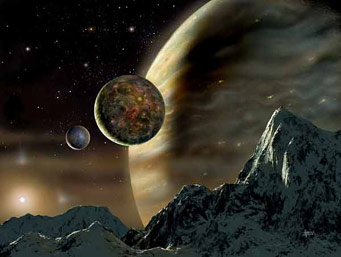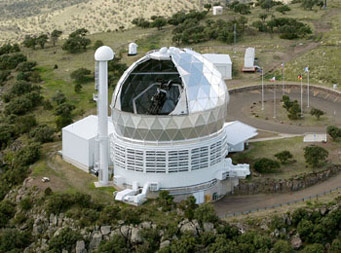
Artist's conception of an extrasolar planet with an orbiting moon.
Discovering new planets that orbit distant stars has become commonplace. But now a team of astronomers has managed to predict the orbit of an extrasolar planet — before anyone knew for certain that it existed. The last time that happened was more than 150 years ago.
The year was 1846. Urbain Le Verrier, a Frenchman, and independently, John Couch Adams of Britain, were puzzled by quirks in the orbit of Uranus. According to Newton's laws of gravitation, the path Uranus traveled around the Sun didn't make sense — unless another, unknown planet was pulling it out of line. When Le Verrier finally convinced an astronomer to look for the ghost planet, it took less than a day to find. The planet was later named Neptune.
The more-recently discovered planet is known by a rather-less-elegant name: HD 74156d. It is a gas giant, slightly more massive than Saturn, orbiting a sun-like star about 65 parsecs (212 light-years) away. Its orbit was predicted in 2004 by Rory Barnes and Sean Raymond, theoretical astronomers then at the University of Washington in Seattle. Three years later, Jacob Bean, an astronomer now at the Georg-August-Universitaet in Goettingen, Germany, announced that he had found the planet, pretty much where Barnes and Raymond said it would be.
In the decade or so since planet-hunting kicked into high gear, nearly 250 planets have been found, but none of them was forecast. Most of these planets were detected using the radial-velocity technique. Astronomers don't see a planet directly, rather they measure a cyclical pattern of shifts in the color of light emitted by a star, caused by the planet tugging the star to and fro as it orbits. These color shifts in a star's light are subtle and difficult to tease out. Larger planets and planets with close-in orbits cause the biggest shifts and are therefore the easiest to detect.
Before HD 74156d was discovered, astronomers already knew of two other giant planets around the same star, one roughly twice the mass of Jupiter, the other about eight times as massive. In such multiple-planet systems, the first hint of the presence of a smaller planet is often a high level of apparent noise in the data that reveal the larger planets. "Noisy" data was what led Bean, then a University of Texas graduate student, to search for additional planets around HD 74156, guided by his UT colleagues, Barbara McArthur and Fritz Benedict. They used the Hobby-Eberly Telescope at the university's McDonald Observatory to collect more than two years of additional radial-velocity data.

McDonald Observatory's Hobby-Eberly Telescope sits atop Mt. Fowlkes in the Davis Mountains of West Texas.
Marty Harris / McDonald Observatory
Barnes was also interested in the noise, but he came at it from a different approach.
The uncertainty in radial-velocity measurements yields a fuzzy picture of a planetary orbit, more like a doughnut of orbital possibilities than a single, crisp ellipse. At the time Barnes did his initial work, only half a dozen multi-planet systems had been found. Working with University of Washington's Thomas Quinn, Barnes ran a thousand computer simulations for each system, all within the known orbital possibilities, but each with a slightly different configuration.
In five of the six systems, they found that some configurations were stable, but that others resulted in a planet literally being thrown out of the system, ejected into space. They were teetering on the brink of instability.
But HD 74156 was different. As a two-planet system — only two of its planets had been discovered at that point — it was stable. None of their simulations led to a planet being ejected.
This work led Barnes and Raymond to develop a new theory: that planetary systems are packed, that they contain as many planets as they possibly can. And that in turn led them to suggest that the HD 74156 system contained a third, smaller companion, lurking undetected between its two larger companions. When they ran a second set of simulations, this time artificially introducing an extra planet, they found that, indeed, HD 74156 made more sense as a three-planet system.
While Bean was conducting his research, however, he was unaware of Barnes and Raymond's theory of packed planetary systems. It wasn't until after he announced his discovery that he got an email from Barnes, informing him that HD 74156d was the first confirmation of a prediction based on the new theory. The orbit, and even the mass, of the planet Bean found were remarkably close to the theoretical planet Barnes and Raymond had envisioned.

Saturn as viewed by NASA's Cassini spacecraft. The newly discovered planet, HD 74156d, is slightly more massive than Saturn.
NASA/JPL/Space Science Institute
The fact Bean was unaware of the prediction made the result all the more significant, said his colleague, Barbara McArthur. "Our job as observers is to report what we seen in the data, without bias toward what we may be 'expected' to see by theoretical models."
As promising as the discovery may be, though, a single data point hardly constitutes proof. "It's exciting to find the first one," said Barnes. "But I'd really like to see them find another one before I really start feeling like this theory has been validated."
Barnes, who is now at the University of Arizona, believes it will be many years before astronomers know whether or not the packed planetary system theory is valid. But if it can rack up a few more successful predictions, it may become a valuable tool in understanding how planetary systems form and evolve, and in guiding planet-hunters in their search.
"This model was based on the idea that planets form easily," said Barnes. "Where you find one, you're going to find a lot more." In most of the planetary systems known to date, only one planet has been found. So far. But Barnes doesn't expect the planetary roster to stay that way. "I will be shocked if one-planet systems tend to be common," he said.
Meanwhile, HD 74156d has another intriguing characteristic. It's in a habitable zone. It circles a Sun-like star in one of the most Earth-like orbits of any planet found to date. Granted: a gas giant larger than Saturn is an unlikely place to look for life. But if the newly discovered planet has giant moons, they are excellent candidates for living worlds.
 0
0
Comments
You must be logged in to post a comment.